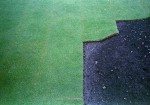Oct
29
2015

I liked this camera so much that I bought another one, that or I forgot I already had one somewhere, you decide. I have it of course because of its 28mm wide angle which isn’t too bad for barrel distortion but suffers from chromatic aberrations. (Light of different wavelengths not arriving exactly at the same spot resulting in colour fringing at edges). Its claim to fame is that it was the first 28mm wide angle point and shoot camera back in 1990. Despite this it isn’t too bad for a point and shoot though it is a large camera. The large size though is only a factor for packing it around it is nice in use unlike the ungainly Nikon Zoom touch 800. I shot two rolls of film back to back with this camera these images are from Kodak Max 400 and gave better results than the Kodak 200 that followed likely because the camera chose a smaller aperture with the faster film. A past post about this camera Konica Zup28W
1 comment | posted in Cameras, Photography
Oct
24
2015

I’ve taken many pictures with this camera model and written many times about it so what is it about it that draws me to it and allowed Olympus to sell so many of them (3.8 million by Olympus’s account) ? There are other great cameras that have developed ‘cult’ status some deserved some are over rated but the Stylus Epic (Mju II) is just a tremendous camera with no pretensions to anything more. If you’ve been looking at other film cameras and then pick up one of these you can’t help but marvel at how small they are. There isn’t a millimeter of space that is wasted. It seems almost impossible that any other 35mm camera could be made smaller and yet it has all the power winding and autofocus that you would expect.
The lens is a superb 4 element 35m f2.8 which again is amazingly small when you compare it against a typical rangefinder lens of f2.8 and similar focal length.
One thing about one camera: To set the Stylus Epic to spot metering and spot focus you need to press both the self timer and flash button at the same time.
The problem I have now is that this one has a light leak and I can’t tell it apart from another one I already had. I guess it’s time to load another roll.
1 comment | posted in Cameras, Photography
Oct
19
2015

This camera belongs to that select group of 35mm zoom cameras that had a wide angle ability of 28mm. It is one of the best as well, they clamshell lens cover is great and a nod should be given to Olympus for pioneering this. The controls on the back though are all Canon and all good with a large rear dial and customizable user mode. The ability to suppress the flash is one of the most important things for me in a point and shoot and the ability to force it always off with this camera make it all the better. The focal range of 28-90mm (f4.5 – f9.9) is versatile and the 7 element lens with 2 aspherics is above average even when considered against less ambitious lenses. This camera came at an interesting moment as well as Canon also released the Powershot G1 digital camera around the same time.

This and cameras like it signaled the end for film cameras and foreshadowed the rapid decline of film.
2 comments | posted in Cameras, Photography
Oct
16
2015

Additional images and post for this camera are here Minolta V2
no comments | posted in Cameras, Photography
Oct
11
2015

I know the arguments for cell phone cameras and I’ve had my own different ones going back to their sub megapixel inception.  (That’s a full size 640×480 image from a cell phone about 12 years ago)
(That’s a full size 640×480 image from a cell phone about 12 years ago)
I’ve seen how far they’ve advanced and taken thousands of images with different ones myself but other than being convenient I have found them to be pretty lacking in quality. They may very well be good enough for almost everything you see on a screen but if you want something with a little more control or some focal length choice they can’t compete with point and shoots or something as versatile as the Pentax Q system. I’m personally willing to carry the extra little bit of weight and bulk so that I can capture images as I wish rather than it being dictated by the technology. My own cell phone camera use peaked several years ago with my mosaic ‘Not My Memory’ which is an ongoing project where as time goes on and I forget the context of individual images I will fade them to black. After that my cell phone picture taking dropped to near irrelevance.

I recognize the convenience of having the camera the processing and the ability to share an image all in one device and they really are good enough for almost everything in that vein but I just don’t enjoy using them as much as a camera with all its ergonomics focused on capturing images, don’t even get my started about the joy of shooting film. So while the world moves on and adjusts their expectations to accept smart phone images as the new norm I will use my Q7 and film for my snapshots. Until I get a new phone of course then I will be all over that 🙂
Here is a gallery of images taken with the Pentax Q7 and various lenses some of them could have easily been taken with a cell phone but of course some not.
no comments | posted in Cameras, Photography
Oct
7
2015

Zoom lenses that offered commonly used focal lengths of around 35-70mm were prevalent in the latter days of manual focus film SLR’s Pentax Lens tests Macro Zooms. The quality though varied greatly so without actually trying them its hard to say how well they will perform. With this in mind I mounted my recently acquired Pentax A 35-70 f4 on a Pentax ME Super with a roll of expired Kodak 400. As you would expect the film is grainy but that doesn’t detract from the intent which is to test the lens. What I am looking for is sharpness across the frame and how much chromatic aberrations it creates as well as the more subjective ‘rendering of out of focus areas’. In all three this lens exceeded my expectations. Even with the aperture wide open the sharpness continues from the center all the way into the corners. There was hardly a hint of any fringing or chromatic aberration although a tougher test on a more demanding digital camera might turn up some I suspect as seen bellow. If you look around the edge of the white petals you will see the softness and fringing of this digital shot at f4.0 that said that goes away by f5.6. I would say this is optically the best SMC A zoom lens in this general focal range that I have come across for use on a digital camera.

And finally the out of focus or ‘bokeh’ areas of the image have nice smooth transitions that add to the three dimensionality. It’s also a very compact lens that isn’t much larger than a prime lens however the main compromise with this lens is the rather slow maximum aperture of f4.
no comments | posted in Cameras, Photography
Oct
3
2015

I’m not sure what freedom you are achieving when using this camera but maybe the first two iterations were very restrictive. Just kidding of course it was Minolta marketing for all the automatic features of the camera: auto exposure, auto focus, auto wind auto film loading, auto Henri Cartier-Bresson (Just kidding I made the last one up) . The amount of user control is very limited though with no exposure compensation and only the ability to force flash fill and not flash off. The lens is a 35mm f2.8 (4 elements in 4 groups). The viewfinder is nice and bright and uncluttered. While it has a sliding lens cover I wouldn’t call it a clam shell, like an Olympus XA because it’s so large, perhaps a giant clam. The larger dimensions of the camera make the lens appear all the smaller in the center but it is an okay little piece of optical gear. I’m refraining from calling it great because it does have soft corners and chromatic aberrations. I like the 1980’s style membrane shutter button it allows for a nice flat top plate that suits the rest of the design and materials.
no comments | posted in Cameras, Photography



































































































































